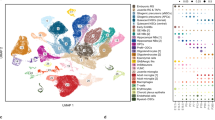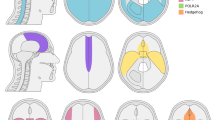Abstract
Meningiomas are among the most common primary central nervous system tumours in adults. Studies focused on the molecular basis for meningioma development are hampered by a lack of information with regard to the cell of origin for these brain tumours. Herein, we identify a prostaglandin D synthase-positive meningeal precursor as the cell of origin for murine meningioma, and show that neurofibromatosis type 2 (Nf2) inactivation in prostaglandin D2 synthase (PGDS) (+) primordial meningeal cells, before the formation of the three meningeal layers, accounts for the heterogeneity of meningioma histological subtypes. Using a unique PGDSCre strain, we define a critical embryonic and early postnatal developmental window in which biallelic Nf2 inactivation in PGDS (+) progenitor cells results in meningioma formation. Moreover, we identify differentially expressed markers that characterize the two major histological meningioma subtypes both in human and mouse tumours. Collectively, these findings establish the cell of origin for these common brain tumours as well as a susceptible developmental period in which signature genetic mutations culminate in meningioma formation.
This is a preview of subscription content, access via your institution
Access options
Subscribe to this journal
Receive 50 print issues and online access
$259.00 per year
only $5.18 per issue
Buy this article
- Purchase on Springer Link
- Instant access to full article PDF
Prices may be subject to local taxes which are calculated during checkout







Similar content being viewed by others
References
Akagi K, Sandig V, Vooijs M, Van der Valk M, Giovannini M, Strauss M et al. (1997). Cre-mediated somatic site-specific recombination in mice. Nucleic Acids Res 25: 1766–1773.
Angelov DN, Vasilev VA . (1989). Morphogenesis of rat cranial meninges. A light- and electron-microscopic study. Cell Tissue Res 257: 207–216.
Beuckmann CT, Lazarus M, Gerashchenko D, Mizoguchi A, Nomura S, Mohri I et al. (2000). Cellular localization of lipocalin-type prostaglandin D synthase (beta-trace) in the central nervous system of the adult rat. J Comp Neurol 428: 62–78.
Catala M . (1998). Embryonic and fetal development of structures associated with the cerebro-spinal fluid in man and other species. Part I: the ventricular system, meninges and choroid plexuses. Arch Anat Cytol Pathol 46: 153–169.
Couly GF, Le Douarin NM . (1987). Mapping of the early neural primordium in quail-chick chimeras. II. The prosencephalic neural plate and neural folds: implications for the genesis of cephalic human congenital abnormalities. Dev Biol 120: 198–214.
da Cruz MJ, Hardy DG, Moffat DA . (2000). Clinical presentation of a group of NF2 patients to a tertiary referral skull base unit. Br J Neurosurg 14: 101–104.
Donehower LA, Harvey M, Slagle BL, McArthur MJ, Montgomery Jr CA, Butel JS et al. (1992). Mice deficient for p53 are developmentally normal but susceptible to spontaneous tumours. Nature 356: 215–221.
Eguchi N, Minami T, Shirafuji N, Kanaoka Y, Tanaka T, Nagata A et al. (1999). Lack of tactile pain (allodynia) in lipocalin-type prostaglandin D synthase-deficient mice. Proc Natl Acad Sci USA 96: 726–730.
Evans DG, Huson SM, Donnai D, Neary W, Blair V, Teare D et al. (1992). A genetic study of type 2 neurofibromatosis in the United Kingdom. I. Prevalence, mutation rate, fitness, and confirmation of maternal transmission effect on severity. J Med Genet 29: 841–846.
Fevre-Montange M, Champier J, Durand A, Wierinckx A, Honnorat J, Guyotat J et al. (2009). Microarray gene expression profiling in meningiomas: differential expression according to grade or histopathological subtype. Int J Oncol 35: 1395–1407.
Giovannini M, Robanus-Maandag E, van der Valk M, Niwa-Kawakita M, Abramowski V, Goutebroze L et al. (2000). Conditional biallelic Nf2 mutation in the mouse promotes manifestations of human neurofibromatosis type 2. Genes Dev 14: 1617–1630.
Gutmann DH, Giordano MJ, Fishback AS, Guha A . (1997). Loss of merlin expression in sporadic meningiomas, ependymomas and schwannomas. Neurology 49: 267–270.
Haines DE, Harkey HL, al-Mefty O . (1993). The ‘subdural’ space: a new look at an outdated concept. Neurosurgery 32: 111–120.
Hartmann C, Sieberns J, Gehlhaar C, Simon M, Paulus W, von Deimling A . (2006). NF2 mutations in secretory and other rare variants of meningiomas. Brain Pathol 16: 15–19.
Hoffmann A, Bachner D, Betat N, Lauber J, Gross G . (1996). Developmental expression of murine beta-trace in embryos and adult animals suggests a function in maturation and maintenance of blood–tissue barriers. Dev Dyn 207: 332–343.
Kalamarides M, Niwa-Kawakita M, Leblois H, Abramowski V, Perricaudet M, Janin A et al. (2002). Nf2 gene inactivation in arachnoidal cells is rate-limiting for meningioma development in the mouse. Genes Dev 16: 1060–1065.
Kalamarides M, Stemmer-Rachamimov AO, Takahashi M, Han ZY, Chareyre F, Niwa-Kawakita M et al. (2008). Natural history of meningioma development in mice reveals: a synergy of Nf2 and p16(Ink4a) mutations. Brain Pathol 18: 62–70.
Kamiryo T, Orita T, Nishizaki T, Aoki H . (1990). Development of the rat meninx: experimental study using bromodeoxyuridine. Anat Rec 227: 207–210.
Kawashima M, Suzuki SO, Yamashima T, Fukui M, Iwaki T . (2001). Prostaglandin D synthase (beta-trace) in meningeal hemangiopericytoma. Mod Pathol 14: 197–201.
Krimpenfort P, Quon KC, Mooi WJ, Loonstra A, Berns A . (2001). Loss of p16Ink4a confers susceptibility to metastatic melanoma in mice. Nature 413: 83–86.
Kros J, de Greve K, van Tilborg A, Hop W, Pieterman H, Avezaat C et al. (2001). NF2 status of meningiomas is associated with tumour localization and histology. J Pathol 194: 367–372.
Krutilkova V, Trkova M, Fleitz J, Gregor V, Novotna K, Krepelova A et al. (2005). Identification of five new families strengthens the link between childhood choroid plexus carcinoma and germline TP53 mutations. Eur J Cancer 41: 1597–1603.
Lakso M, Pichel JG, Gorman JR, Sauer B, Okamoto Y, Lee E et al. (1996). Efficient in vivo manipulation of mouse genomic sequences at the zygote stage. Proc Natl Acad Sci USA 93: 5860–5865.
Le Lievre CS, Le Douarin NM . (1975). Mesenchymal derivatives of the neural crest: analysis of chimaeric quail and chick embryos. J Embryol Exp Morphol 34: 125–154.
Lee JH, Sade B, Choi E, Golubic M, Prayson R . (2006). Meningothelioma as the predominant histological subtype of midline skull base and spinal meningioma. J Neurosurg 105: 60–64.
Louis DN, Scheitauer BW, Budka H, von Deimling A, Kepes JJ . (2000). Meningiomas. In: Kleihues P, Cavenee WK (eds). Pathology and Genetics of Tumours of the Nervous System. IARC Press: Lyon, pp 176–184.
Marino S, Vooijs M, van Der Gulden H, Jonkers J, Berns A . (2000). Induction of medulloblastomas in p53-null mutant mice by somatic inactivation of Rb in the external granular layer cells of the cerebellum. Genes Dev 14: 994–1004.
McBratney-Owen B, Iseki S, Bamforth SD, Olsen BR, Morriss-Kay GM . (2008). Development and tissue origins of the mammalian cranial base. Dev Biol 322: 121–132.
McClatchey AI, Saotome I, Mercer K, Crowley D, Gusella JF, Bronson RT et al. (1998). Mice heterozygous for a mutation at the Nf2 tumor suppressor locus develop a range of highly metastatic tumors. Genes Dev 12: 1121–1133.
McLone DG, Bondareff W . (1975). Developmental morphology of the subarachnoid space and contiguous structures in the mouse. Am J Anat 142: 273–293.
Nakamura M, Roser F, Michel J, Jacobs C, Samii M . (2003). The natural history of incidental meningiomas. Neurosurgery 53: 62–70; discussion 70-1.
Nakasu S, Hirano A, Shimura T, Llena JF . (1987). Incidental meningiomas in autopsy study. Surg Neurol 27: 319–322.
Olivero WC, Lister JR, Elwood PW . (1995). The natural history and growth rate of asymptomatic meningiomas: a review of 60 patients. J Neurosurg 83: 222–224.
Pietri T, Eder O, Blanche M, Thiery JP, Dufour S . (2003). The human tissue plasminogen activator-Cre mouse: a new tool for targeting specifically neural crest cells and their derivatives in vivo. Dev Biol 259: 176–187.
Robanus-Maandag E, Giovannini M, van der Valk M, Niwa-Kawakita M, Abramowski V, Antonescu C et al. (2004). Synergy of Nf2 and p53 mutations in development of malignant tumours of neural crest origin. Oncogene 23: 6541–6547.
Ruttledge MH, Xie YG, Han FY, Peyrard M, Collins VP, Nordenskjold M et al. (1994). Deletions on chromosome 22 in sporadic meningioma. Genes Chromosomes Cancer 10: 122–130.
Schwechheimer K, Kartenbeck J, Moll R, Franke WW . (1984). Vimentin filament–desmosome cytoskeleton of diverse types of human meningiomas. A distinctive diagnostic feature. Lab Invest 51: 584–591.
Stuart JE, Lusis EA, Scheck AC, Coons SW, Lal A, Perry A et al. (2010). Identification of gene markers associated with aggressive meningioma by filtering across multiple sets of gene expression arrays. J Neuropathol Exp Neurol (e-pub ahead of print 11 December 2010).
Tohma Y, Yamashima T, Yamashita J . (1992). Immunohistochemical localization of cell adhesion molecule epithelial cadherin in human arachnoid villi and meningiomas. Cancer Res 52: 1981–1987.
Urade Y, Kitahama K, Ohishi H, Kaneko T, Mizuno N, Hayaishi O . (1993). Dominant expression of mRNA for prostaglandin D synthase in leptomeninges, choroid plexus, and oligodendrocytes of the adult rat brain. Proc Natl Acad Sci USA 90: 9070–9074.
Vandenabeele F, Creemers J, Lambrichts I . (1996). Ultrastructure of the human spinal arachnoid mater and dura mater. J Anat 189 (Part 2): 417–430.
Vernooij MW, Ikram MA, Tanghe HL, Vincent AJ, Hofman A, Krestin GP et al. (2007). Incidental findings on brain MRI in the general population. N Engl J Med 357: 1821–1828.
Yamashima T, Sakuda K, Tohma Y, Yamashita J, Oda H, Irikura D et al. (1997). Prostaglandin D synthase (beta-trace) in human arachnoid and meningioma cells: roles as a cell marker or in cerebrospinal fluid absorption, tumorigenesis, and calcification process. J Neurosci 17: 2376–2382.
Yoshida T, Vivatbutsiri P, Morriss-Kay G, Saga Y, Iseki S . (2008). Cell lineage in mammalian craniofacial mesenchyme. Mech Dev 125: 797–808.
Acknowledgements
We thank A Berns for p16Ink4a and p53flox mutant mice; S Dufour and JP Thiery for HtPACre mice; Y Urade for the PGDS genomic fragment; M Pla and staff of the Institut Universitaire d’Hematologie (IUH), Universite Paris 7, for mouse housing; N Karboul for technical assistance; and M Catala and W Van Furth for helpful discussions. This work was supported by Grants from the US Army Medical Research and Materiel Command (DAMD17-02-1-0645 to MG), James S McDonnell Foundation (to DHG and MG), Association Neurofibromatoses et Recklinghausen, the Vincent Buono Research Fund (to DHG and MG) and Inserm.
Author information
Authors and Affiliations
Corresponding author
Ethics declarations
Competing interests
The authors declare no conflict of interest.
Additional information
Supplementary Information accompanies the paper on the Oncogene website
Rights and permissions
About this article
Cite this article
Kalamarides, M., Stemmer-Rachamimov, A., Niwa-Kawakita, M. et al. Identification of a progenitor cell of origin capable of generating diverse meningioma histological subtypes. Oncogene 30, 2333–2344 (2011). https://doi.org/10.1038/onc.2010.609
Received:
Revised:
Accepted:
Published:
Issue Date:
DOI: https://doi.org/10.1038/onc.2010.609
Keywords
This article is cited by
-
Meningioma animal models: a systematic review and meta-analysis
Journal of Translational Medicine (2023)
-
Respective roles of Pik3ca mutations and cyproterone acetate impregnation in mouse meningioma tumorigenesis
Cancer Gene Therapy (2023)
-
Metastatic meningioma: a case series and systematic review
Acta Neurochirurgica (2023)
-
Trans-eyebrow supraorbital endoscope-assisted keyhole approach to suprasellar meningioma in pediatric patient: case report and literature review
Chinese Neurosurgical Journal (2022)
-
Are there predilection sites for intracranial meningioma? A population-based atlas
Neurosurgical Review (2022)



